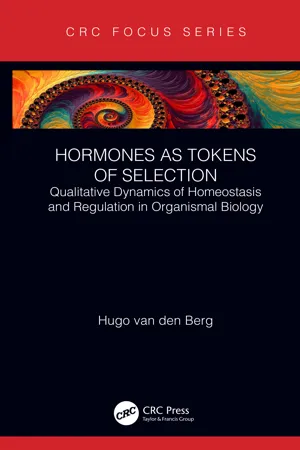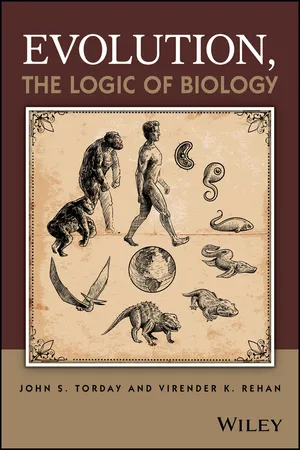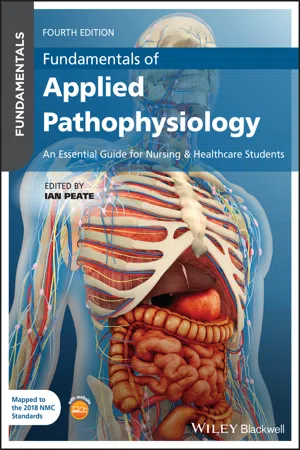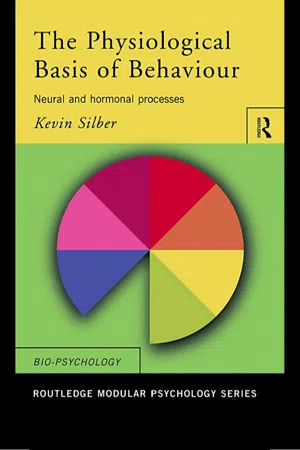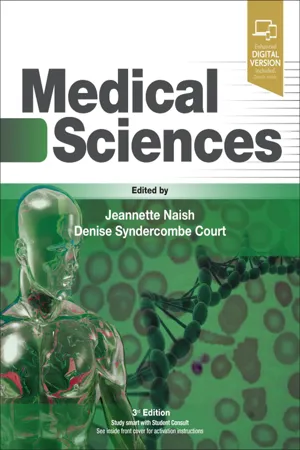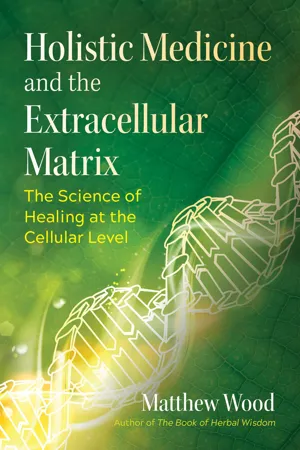Biological Sciences
Homeostasis
Homeostasis is the body's ability to maintain stable internal conditions despite external changes. It involves processes such as temperature regulation, blood sugar control, and pH balance. This dynamic equilibrium is essential for the proper functioning of cells, tissues, and organs within an organism.
Written by Perlego with AI-assistance
Related key terms
10 Key excerpts on "Homeostasis"
- eBook - ePub
Hormones as Tokens of Selection
Qualitative Dynamics of Homeostasis and Regulation in Organismal Biology
- Hugo van den Berg(Author)
- 2019(Publication Date)
- CRC Press(Publisher)
Chapter 2The nature of HomeostasisHomeostasis refers to the tendency to maintain a constant or near-constant internal environment for the biochemical and physiological processes of life [102 ]. Familiar examples at the cellular level include the cytosolic concentrations of chemical species that affect the rates of metabolism (e.g. [H3 O+ ], [ATP], the intermediates of the Krebs† cycle) and at the organismal level physico-chemical parameters of interstitial fluids and blood, such as temperature, pressure, oxygenation, nutrient concentrations [78 ]. By maintaining such variables at constant or near-constant values, the body creates a stable and predictable milieu intérieur providing steady operating conditions for the processes of life, even when the organism’s ambient environment, the milieu extérieur , undergoes marked fluctuations or is severely perturbed.At the heart of Homeostasis lies the principle of feedback control , also known as closed loop control. Life scientists perhaps shy away from the term ‘control’ to avoid unintended teleological imputations and may prefer to speak of regulation ; however, the hallmark of regulation is the use of feedback to attain what engineers unabashedly call ‘desired behaviour’ [64 ]. In a biological context, ‘desirable’ has to be understood as a shorthand for ‘conferring adaptive value,’ as we will argue in Section 2.1 . Moreover, the biological context requires a slightly different mathematical formalism than the classic engineering context, because coarse-graining and time-scale arguments are essential for tractable models of complex biological systems [11 ]. The basic notions and notations used in the chapters that follow are introduced in Section 2.2 .2.1The Origins of HomeostasisInformation science in its broadest meaning presents itself as the medium of choice for the study of biological regulation. Control and Homeostasis find a natural fit in what used to be called cybernetics , the theory and craft of process control (from κυβερνητική, the art of the maritime pilot). However, there are differences in outlook and parlance which engender unnecessary confusion and debate. For instance, control engineers call the value that is maintained the ‘reference value,’ or ‘desired value,’ or ‘set-point’ [39 ], terms which may worry the biologist, since the system operates without conscious desires or goal-orientation [38 ].‡ - eBook - ePub
- John S. Torday, Virender K. Rehan(Authors)
- 2017(Publication Date)
- Wiley(Publisher)
Evolutionary Theory: the Unfinished Synthesis, R.G.B. Reid pointed out the paradoxical relationship between Homeostasis and evolution, though he failed to invoke either a developmental or phylogenetic dimension. The bottom line is that biologists commit a systematic error in describing the different phases of the life cycle without considering the mechanistic interrelationships between them, which must logically exist, but the data have been siloed within the various subdisciplines of biology. It is this fractious nature of descriptive biology that is hindering our understanding of what evolution actually constitutes.The Historic Concept of Homeostasis, from Bernard to Cannon
Homeostasis is defined as the property of a system in which variables are regulated so that internal conditions remain stable and relatively constant. Examples of Homeostasis include the regulation of temperature and the balance between acidity and alkalinity. It is a process that maintains the stability of the organism’s internal environment in response to fluctuations in external conditions.The conceptualization of Homeostasis as the milieu intérieur was first described by Claude Bernard in his book An Introduction to the Study of Experimental Medicine in 1865. The term Homeostasis was coined by Walter Bradford Cannon in his Organization for Physiological Homeostasis in 1926. Conrad Waddington preferred the more dynamic term homeorhesis. Although the term was originally used to refer to processes within living organisms, it is frequently applied to automatic control systems. Homeostasis requires a sensor that is sensitive and specific to the condition being regulated, an effector mechanism that can vary in response to that condition, and a negative feedback connection between the two.All living organisms depend on maintaining a complex set of interacting metabolic chemical reactions. From the simplest unicellular organisms to the most complex plants and animals, internal processes operate to keep the conditions within tight limits to allow these reactions to proceed. Homeostatic processes act at the level of the cell, the tissue, and the organ - eBook - ePub
Fundamentals of Applied Pathophysiology
An Essential Guide for Nursing and Healthcare Students
- Ian Peate, Ian Peate(Authors)
- 2021(Publication Date)
- Wiley-Blackwell(Publisher)
This chapter introduces the reader to the concept of Homeostasis. Homeostasis is the key to life, and vital signs, for example, are a measure of Homeostasis. Being healthy for many people means being independent of clinical intervention and to be able to undertake the activities of living. In order to do this, the body needs to engage with Homeostasis. Understanding the theoretical underpinning of Homeostasis for health is essential for safe and effective care, for accurate clinical decision‐making and for restoration of patients to health.The word Homeostasis is derived from the Greek words for ‘similar’ and ‘standing still’; the term refers to any process that living things employ to actively maintain stable conditions that are necessary for survival. In 1930 the term was used by Walter Cannon, a doctor. In his text, The Wisdom of the Body, he describes how the body maintains constant levels of temperature and other vital conditions, for example, the water, salt, sugar, protein, fat, calcium and oxygen contents of the blood.In health, the body does all the work that is required to maintain itself by a wide range of living processes, including the excretion of waste products and the inhalation of oxygen so as to release energy from sugar. It also uses the process of Homeostasis to maintain itself in balance, it makes just the right number of cells to replace those cells that have worn out and it produces just the right amount of hormones to signal a reaction that is needed to make things happen. Maintaining Homeostasis requires the body to continuously monitor its internal conditions. From body temperature to blood pressure to the levels of certain nutrients, each physiological condition has a particular set point. When disruption of Homeostasis is mild and temporary, the cells of the body can quickly restore balance in the internal environment. However, if disruption is sustained and extreme, then Homeostasis may fail (Tortora and Derrickson 2017 - eBook - ePub
The Physiological Basis of Behaviour
Neural and Hormonal Processes
- Kevin Silber(Author)
- 2005(Publication Date)
- Routledge(Publisher)
6 HomeostasisIntroduction
In this chapter we consider Homeostasis as an example of how the CNS, ANS and endocrine system work together. The term Homeostasis refers to the maintenance of a relatively stable state within our bodies. In the first part of the chapter we take a closer look at exactly what this means. The rest of the chapter details three major homeostatic mechanisms, namely, the regulation of our nutritional content (eating), the regulation of our water content (drinking), and the regulation of our body heat (temperature regulation). As you work through the chapter you will see that all three mechanisms are kept in balance by a combination of hormonal and ANS activity, all of which is coordinated by central brain processes.What is Homeostasis?
There are a number of features of Homeostasis that are worth pointing out before we look at the details.As I am writing this book in World Cup year I will start, if I may, with a football analogy. Imagine that you want to have a game of football. If the ball is not pumped up enough then it will not bounce properly. If it is blown up too much then it will burst. Indeed, professional footballers will tell you that small diversions from the correct pressure make it difficult to play properly. There is, therefore, a limited range of pressures over which the football can function as a football. The same is true of the constituents of our bodies. For example, many of the chemical reactions in our body are helped by the presence of enzymes. Enzymes will only work within a limited temperature range. Therefore, the body must maintain its temperature within certain limits. The mechanisms for this and all of the other balances are called homeostatic mechanisms.- The ideal range for any component is called the set point
- eBook - ePub
Biocracy
Public Policy And The Life Sciences
- Lynton Keith Caldwell(Author)
- 2019(Publication Date)
- Routledge(Publisher)
The concept of dynamic Homeostasis is implicit in the following observation by biologist Rene Dubos:Homeostasis in its widest context includes the coordinated physiological processes which maintain most of the steady states in organisms. Similar general principles may apply to the establishment, regulation, and control of steady states for other levels of organization. It must be emphasized that Homeostasis does not necessarily imply a lack of change, because the “steady states” to which the regulatory mechanisms are directed may shift with time. But throughout the change they remain under more or less close control.Such a concept can therefore be applied to organizations at cellular, organ system, individual, and social levels. It may be considered in relation to time intervals ranging from milliseconds to millions of years. Its essential feature is the interplay of factors which tend to maintain a given state at a given time.3There is evident everywhere in nature a close correspondence between most of the structures and activities of living things and the needs imposed upon them by their places in nature. The necessary outcome of this relationship is a dynamic equilibrium which implies inseparability of life and environment, and which has fitness as a consequence.4The principal intellectual problem in the recent history of thought on societal Homeostasis has been to ascertain the validity of extrapolating a physiological theory to a social hypothesis. Societal Homeostasis as a philosophic proposition is as old as articulated concepts of man’s relationship to nature; as a scientific proposition, however, its origin appears to be in experimental physiology, and in this sense it is a “modern” concept. For the greater part of the century following publication of Claude Bernard’s An Introduction to the Study of Experimental Medicine (1865),5 the principal contributions to thought on Homeostasis were made by biologists. Two lines of inquiry developed out of Bernard’s concern with organic interactions in relation to environmental factors. The first of these was physiological Homeostasis and is exemplified by Lawrence J. Henderson’s The Fitness of the Environment (1913),6 and especially by Walter B. Cannon’s, The Wisdom of the Body (1932).7 - eBook - ePub
- Jack A. Tuszynski, Michal Kurzynski(Authors)
- 2003(Publication Date)
- CRC Press(Publisher)
to remain thse same .Homeostasis is a remarkable property of highly complex open systems. A homeostatic entity such as a cell, a large industrial organization, or a society of ants is an open system that maintains its structure and functions using multiple dynamic equilibria closely controlled by interdependent control mechanisms. Such a system reacts to even minute environmental changes through a series of modifications of equal size and opposite direction to those that created the disturbance. The goal of these modifications is to maintain all the internal partial balances and eventually the overall system equilibrium.Ecological, biological, and social systems are homeostatic. They oppose change using all the means at their disposal. If a system does not succeed in reestablishing its equilibria, it enters another mode of behavior, one with constraints often more severe than the previous ones. This new mode into which the system may be forced to bifurcate can lead to the destruction of the system if the disturbances persist and are not countered.Complex systems must possess Homeostasis to maintain their stability and survive. Homeostatic systems are ultrastable. Everything in their internal, structural, and functional organizations contributes to the maintenance of their organizational order. According to Jay Forrester (1961, 1973) their behavior is unpredictable, “counterintuitive,” or contravariant. When one expects a determined reaction as a result of a precise action, a completely unexpected and often contrary action occurs. For a complex system such as a school of fish or an ant colony, mere survival is not enough. It must find a way to adapt to modifications of the environment and evolve in the process. Otherwise, outside forces eventually disorganize and destroy it. However, it is a major challenge and always an open question for a stable organization whose goal is survival to find a way to adapt to change and evolve as a result of it. This concept is as relevant to an endangered species as it is to countries or even the human race as a whole. Some possible answers to this enigma can be found when we study the thermodynamics of living systems. - eBook - ePub
- Jeannette Naish, Denise Syndercombe Court, Jeannette Naish, Denise Syndercombe Court(Authors)
- 2018(Publication Date)
- Elsevier(Publisher)
Chapter 16 is about the nutritional needs for humans to stay alive and, more importantly, the principles for assessing these needs in health and disease. What makes a human being eat or not eat is also addressed, with implications for dietary control of conditions such as obesity and some therapeutic diets for chronic conditions such as inflammatory bowel disease. The association between diet and disease is also discussed. Nutritional support during severe illness, artificial nutrition, and associated complications are discussed. Artificial nutrition includes enteral feeding, i.e. putting feeding liquid directly into the stomach or small intestine, and parenteral nutrition, which is intravenous feeding. The makeup of the feeding fluid will depend on the nutritional needs of the patient. These principles are important, especially during the foundation years. Inclusion of nutrition as a basic science in this book is perhaps unusual, but clinicians need to know about these principles for sustaining life.Homeostasis
To maintain the normal physiological processes for sustaining life, all living organisms and cells have to maintain a stable internal environment in response to changes in external conditions. Physiologists have called this function Homeostasis , from the Greek homeo meaning same or unchanging, and stasis meaning standing still. When an attribute of the organism or cell (such as pH or temperature) changes for any reason, this complex system of processes adjusts the attribute back to the set constant level needed for physiological functioning. Such an attribute is labelled a variable , something that is changeable.Homeostatic systems are multiple, dynamic mechanisms that are regulated (or controlled) for making the adjustments necessary for a stable internal environment; this is unlike simple dynamic equilibrium or steady states that are not regulated. Many examples of human Homeostasis are discussed in the following chapters. Disease ensues when homeostatic mechanisms break down and the body exhibits symptoms (what the patient experiences) and signs (what the clinician finds on clinical examination).Many physiological parameters, such as blood glucose level (discussed in detail in Ch. 3 , Energy and metabolism), water and electrolyte (sodium, potassium, calcium, etc.) balance and body temperature, are examples of precise control by homeostatic mechanisms. Of the homeostatic mechanisms that control body fluids, fluid balance (the control of fluid volumes) and acid–base balance (the control of acidity [H+ - eBook - ePub
Holistic Medicine and the Extracellular Matrix
The Science of Healing at the Cellular Level
- Matthew Wood(Author)
- 2021(Publication Date)
- Healing Arts Press(Publisher)
Appendix Homeostasis: Balance in the MatrixThe fixity of the milieu supposes a perfection of the organism such that the external variations are at each instant compensated for and equilibrated. . . . All of the vital mechanisms, however varied they may be, have always one goal, to maintain the uniformity of the conditions of life in the internal environment The stability of the internal environment is the condition for the free and independent life.CLAUDE BERNARD (QUOTED IN GROSS 1998, 383)Now we will move on to an overview of the basic processes and patterns that regulate the natural flux of the extracellular matrix. This includes (1) terminology describing balance, stress, and response in the organism (2) patterns of imbalance, and (3) different types of reactions to medicinal substances. These concepts were difficult for me to grasp, they are difficult to explain, and, because of this, I feel this chapter may be awkwardly written at times. So I want to apologize to you at the outset. There is also the problem that Cannon and Selye, who developed our understanding of Homeostasis, stress, and adaptation, worked long before many of the discoveries in this book. Therefore, their discussion is limited to the neuroendocrine system.HomeostasisAn American doctor, Walter Cannon (1871–1945), studied in Paris and particularly esteemed Claude Bernard, whose milieu intérieur lead inevitably to Cannon’s concept of Homeostasis. This term describes the ongoing self-regulation of the organism in a steady state. The word Homeostasis conveys the idea that the body always seeks to return to a like (homeo ) state (stasis ).The coordinated physiological reactions which maintain most of the steady states in the body are so complex, and are so peculiar to the living organism, that [I have] suggested . . . that a specific designation for these states be employed—Homeostasis. (Cannon 1929, 400)Homeostasis was not just a concept, however. Cannon also was trying to explain the operation of the adrenal medulla and the hormones associated with it: adrenaline (epinephrine) and noradrenaline (norepinephrine). He coined the phrase “fight-or-flight” to explain the action of these hormones. - eBook - ePub
Attachment Theory and Research
A Reader
- Tommie Forslund, Robbie Duschinsky, Tommie Forslund, Robbie Duschinsky(Authors)
- 2021(Publication Date)
- Wiley-Blackwell(Publisher)
In order to survive in any environment, especially those undergoing changes, large or small, living organisms must maintain themselves in a comparatively steady state. Such steady state can be measured along numerous parameters, which can be grouped into a few major categories of Homeostasis. Some refer to the organism’s interior state, some to its relation with the outside world.The category of Homeostasis first described by Claude Bernard, and for which Walter Cannon (1932)1 coined the term, concerns a set of physiochemical measures interior to the organism. This category can be termed physiological Homeostasis. Another set of measures also interior to the organism that are usually held even steadier, by healing processes, are those relating to body structure: this category can be termed morphological Homeostasis. A third set of measures also held steady is well recognised by field biologists, namely the tendency for animals of any one species to remain within the limited range of environmental conditions to which the species is adapted – its ecological niche. Maintenance of an animal within its ecological niche is effected by a variety of behaviour patterns, the activation of which are sensitive to features of the environment. This category can be termed ecological Homeostasis.These three categories apply to all species of animal, and the first two apply also to plants. The biological control systems that maintain these categories of Homeostasis are, for morphological Homeostasis, physiological systems; for ecological Homeostasis, behavioural systems; and for physiological Homeostasis, both physiological and behavioural systems.These three categories of Homeostasis are intimately linked: by maintaining an animal within its ecological niche, the behavioural systems maintaining ecological Homeostasis are acting in ways that greatly facilitate maintenance of morphological and physiological Homeostasis.I believe that at least two other categories of Homeostasis can be recognised; they become increasingly evident in the higher animal phyla and play a great part in the lives of higher vertebrates and man. One of these categories refers to a special aspect of the organism’s interior state, the other to a special aspect of its relation to the environment. We start with the latter. - eBook - ePub
- Julie Wilkinson(Author)
- 2012(Publication Date)
- For Dummies(Publisher)
internal environment (everything under your skin: think cells, liquids, tissues) using positive and negative feedback mechanisms and your central nervous system. Put simply: If you’re cold, you shiver; if you’re hot, you sweat. This is Homeostasis in action — your body on autopilot. Most of the time, this process keeps things on an even keel. However, autopilot isn’t always the best option when it comes to your pH or your diet.Who thought up the word Homeostasis ?The word Homeostasis actually comes from the Greek. The prefix homeo means “same, unchanging, static.” The suffix –stasis translates to “standing,” so Homeostasis is loosely translated to “standing unchanged.”Sir Walter Cannon coined the term Homeostasis in 1933. He was trying to find a superior word to describe the body’s internal balance, and he found the word equilibria lacking.Claude Bernard explored the concept of milieu interier — regulating the internal environment, or what we now know as Homeostasis — in the 1800s through his teaching about the concepts of the interior and exterior human environment and impacts. (He was also the first to establish the functions of sugar metabolism in the liver — but that’s a whole other book!)Homeostasis is not something you can control — it is an innate function constantly working behind the scenes. What you can control is how much acid you dump into your system — and ease the behind the scenes workload on your body.In terms of biological feedback, positive does not mean “good” and negative does not equal “bad.” Positive feedback amplifies a situation in your body whereas negative feedback returns things to baseline. Shivering when you are chilly is a result of your nervous system recognizing that you are cold. The negative feedback is the shivering, which should generate heat and bring your core temperature back to normal. Milk production when a mother is breastfeeding is an example of positive feedback. The baby suckles, more milk is created, more milk is released.You use your body’s defenses for your own good when you make the switch to an acid alkaline diet by using negative feedback. When you stop feeding your tissues acids, your body can fine-tune your pH balance from there, instead of constantly working to fix a chronic imbalance. Your body likes an alkaline environment. If you are too acidic, cells start to die.
Index pages curate the most relevant extracts from our library of academic textbooks. They’ve been created using an in-house natural language model (NLM), each adding context and meaning to key research topics.
